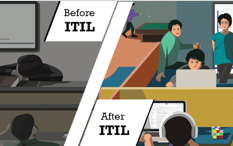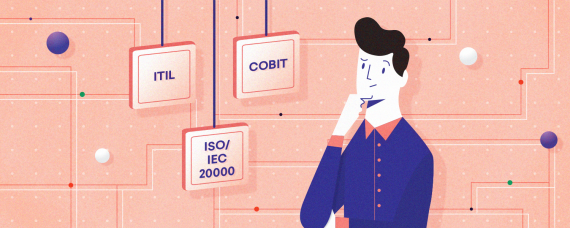ITIL Service Strategy
The purpose of Service Strategy is to provide a strategy for the service lifecycle and to ensure that the service is fit for purpose and fit for use. The strategy should be in sync with the organizations business objectives as well as customer needs. Starting from an assessment of customer needs and the marketplace, the Service Strategy lifecycle stage determines which services the IT organization is to offer and what capabilities need to be developed.
-
Strategy Management for IT Services - Assess the service provider's offerings, capabilities, competitors as well as current and potential market spaces to develop a strategy to serve customers.
-
Service Portfolio Management - Ensures that the service provider has the right mix of services to meet the required business outcomes at an appropriate level of investment.
-
Financial Management for IT Services - Manage the service provider's budgeting, accounting, and charging requirements.
-
Demand Management - Understand, anticipate and influence customer demand for services to ensure that the service provider has sufficient capacity to meet the required demand.
-
Business Relationship Management - Identifies the needs of existing and potential customers and ensures that appropriate services are developed to meet those needs.
Within Service Strategy, Service Portfolio Management helps the organization manage services as a holistic portfolio; demand management is concerned with understanding and influencing customer demand by modeling user profiles and patterns of business activity; Financial Management is concerned with understanding costs and opportunities associated with services in financial terms. Working together, these processes provide the capability for your organization to make informed decisions about what services to provide and how they should be constructed.
ITIL Service Design
The Service Design lifecycle phase is about the design of services and all supporting elements for introduction into the live environment. The scope of the Service Design lifecycle stage includes the design of new services, as well as changes and improvements to existing ones.
-
Design Coordination - Ensures the consistent and effective design of new or changed IT services, service management information systems, architectures, technology, processes, information, and metrics.
-
Service Catalog Management - Ensure that a Service Catalog is produced and maintained, containing accurate information on all operational services and those being prepared to be run operationally.
-
Service Level Management - Negotiate Service Level Agreements with the customers, designing services in accordance with the agreed service level targets and ensuring that all Operational Level Agreements and Underpinning Contracts are appropriate.
-
Risk Management - Identify, assess and control risks, including analyzing the value of assets to the business, identifying threats to those assets, and evaluating how vulnerable each asset is to those threats.
-
Capacity Management - Ensure that the capacity of IT services and the IT infrastructure is able to deliver the agreed service level targets in a cost-effective and timely manner.
-
Availability Management - Responsible for ensuring that all IT infrastructure, processes, tools, roles, etc. are appropriate for the agreed availability targets.
-
IT Service Continuity Management - Ensures that the IT service provider can always provide minimum agreed Service Levels, by reducing the risk from disaster events to an acceptable level and planning for the recovery of IT services.
-
Information Security Management - Ensure the confidentiality, integrity and availability of an organization's information, data and IT services.
-
Compliance Management - Ensure IT services, processes and systems comply with enterprise policies and legal requirements.
-
Architecture Management - Define a blueprint for the future development of the technological landscape, considering the service strategy and newly available technologies.
-
Supplier management - Ensure that all contracts with suppliers support the needs of the business and that all suppliers meet their contractual commitments.
The purpose of ITIL Service Design is to ensure that the services being developed fulfill the organizational intent described in service strategy and take into consideration things like supportability, risk management, and business continuity. The more service integration and management issues that can be addressed during service design, the easier service transition becomes.
ITIL Service Transition
The objective of ITIL Service Transition is to build and deploy IT services and ensure that changes to services and service management processes are carried out in a coordinated and safe way.
-
Change Management - Control the lifecycle of all changes to enable beneficial changes to be made, with minimum disruption to IT services.
-
Change Evaluation - Assess major changes before those changes are allowed to proceed to the next phase in their lifecycle.
-
Project Management - Plan and coordinate the resources to deploy a major release within the predicted cost, time and quality estimates.
-
Application Development - The development and maintenance of custom applications as well as the customization of products from software vendors to provide the IT services that users need.
-
Release and Deployment Management - Plan, schedule and control the movement of releases to test and live environments -ensuring that the integrity of the live environment is protected and that the correct components are released.
-
Service Validation and Testing - Ensure that deployed releases and the resulting services meet customer expectations, and to verify that IT operations can support new services.
-
Service Asset and Configuration Management - Maintain information about configuration items required to deliver an IT service, including their relationships.
-
Knowledge Management - Gather, analyze, store and share knowledge and information - improving efficiency by reducing the need to rediscover knowledge.
In this phase of the lifecycle, the design is built, tested and moved into production to enable the business customer to achieve the desired value. This phase addresses managing changes and transition planning to ensure that all stakeholders are prepared for the service release.
ITIL Service Operation
The objective of ITIL Service Operations is to make sure that IT services are delivered effectively and efficiently by fulfilling user requests, resolving service failures, fixing problems and carrying out routine operational tasks
-
Event Management - Ensure CIs and services are constantly monitored, and to filter and categorize events to decide on appropriate actions
-
Incident Management - Manage the lifecycle of all incidents to return the IT service to users as quickly as possible. Provides permanent or temporary resolution to end-users to restore normalcy as soon as possible
-
Request Fulfillment - Fulfill service requests, which in most cases are minor changes and/or requests for information.
-
Access Management - Grant authorized users the right to use a service while preventing access to non-authorized users.
-
Problem Management - Manage the lifecycle of problems to prevent Incidents from happening, and to minimize the impact of incidents that cannot be prevented. Root cause analysis, RCA is performed to find a permanent solution
-
IT Operations Control - Monitor and control the IT services and their underlying infrastructure, including the execution of day-to-day routine tasks related to the operation of infrastructure components and applications.
-
Facilities Management - Manage the physical environment where the IT infrastructure is located, including things like power and cooling, building access management, and environmental monitoring.
-
Application Management - Responsible for managing applications throughout their lifecycle and making decisions to support continuous improvement of application components.
-
Technical Management - Provides technical expertise and support for the management of the IT infrastructure
-
Closure - Set up an automation rule to automate ticket closure process or let end users close tickets themselves through the self-service portal.
Service operations oversee the daily overall health of the services that are delivered to users and business functions. This includes managing disruptions to service and ensuring restoration after incidents; and determining the root cause of problems. It also includes service desk activities such as handling end-user requests and managing service access permissions.
ITIL Continual Service Improvement
The Continual Service Improvement (CSI) process uses methods from quality management to learn from past successes and failures and improve the overall quality, cost performance and/or usability features to an existing service.
-
Service Review - Review business services and infrastructure services on a regular basis to improve service quality and to identify more economical ways of providing a service.
-
Process Evaluation - Evaluate processes on a regular basis, including identifying areas where the targeted process metrics are not reached and holding regular audits, maturity assessments and reviews.
-
Definition of CSI Initiatives - Defining specific initiatives aimed at improving services and processes, based on the results of service reviews and process evaluations.
-
Monitoring of CSI Initiatives - Verifying that improvement initiatives are proceeding according to plan and introducing corrective measures where necessary.
The Continual Service Improvement process aims to continually improve the effectiveness and efficiency of IT processes and services. Companies will often structure their improvement efforts into CSI Initiatives which are prioritized and managed ad projects as compared to other service management tasks that are treated as ongoing operations. The objective of CSI initiatives is to define and execute specific efforts aimed at improving services and processes based on the results of service reviews and process evaluations.
These 5 stages of the ITIL Service Lifecycle work together to support all aspects of service management including the creation of new services and making changes to existing services. Deciding which lifecycle stages are most important for your organization requires a solid understanding of your organization’s culture, strengths, and weaknesses so you can focus on the processes that will have the greatest impact on your company.












